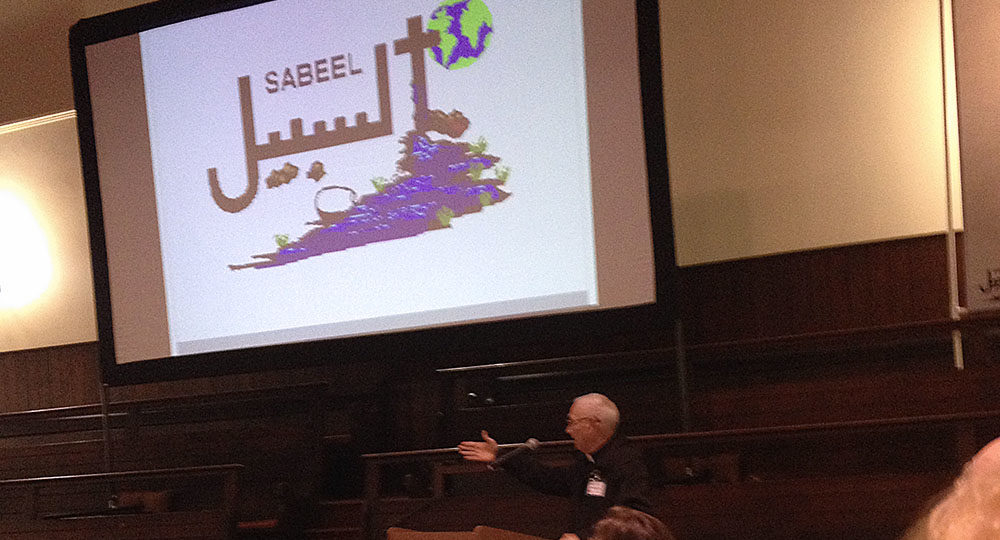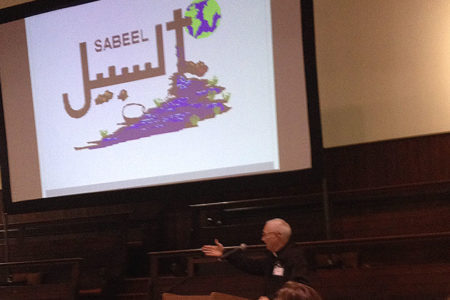The Art of Reframing: Palestinian Liberation Theology
Since Israel’s rebirth as a nation, violence against the Jewish people living in the land has continued with barely a lull. Israelis have lived through three wars of survival, two intifadas, hundreds of suicide bombings, and thousands of mortar and rocket attacks on their civilian population. These facts are well documented. But a new, less familiar assault comes from an unexpected source—the broader Palestinian-Christian community.
It began in 1989 when Anglican priest Dr. Naim Ateek convened a small committee of clergy and lay people “to implement, on a practical level”1 his brainchild: Palestinian Liberation Theology (PLT). He wanted to explore ways in which his theology could be developed and shared with other Palestinian Christians. Soon the Sabeel Ecumenical Liberation Theology Center in Jerusalem was born—founded and directed by Naim Ateek.
It didn’t take long for PLT to reach the West, as Friends of Sabeel chapters began opening in Australia, the United Kingdom, Ireland, Canada, and the United States.
I had my first exposure to PLT when a man approached the FOI Gospel Ministry literature table at a large venue in Vancouver, BC, Canada. His diatribe included spicy references to my “ignorance” about the “real” Israel.
To be honest, I was shocked—not because there are people who have no compunction about dismissing decades of violence against the Jewish people in the land, but because this man was a professing Christian from another ministry. He was so belligerent that men from other ministries who witnessed the encounter said they would have intervened if he became violent.
The topic of conversation throughout the remainder of the conference was “How could Christians embrace this unbiblical attitude toward Israel and the conflict in the Middle East?”
That was more than a decade ago. Since then, Palestinian Liberation Theology has gained much traction, and Sabeel is making inroads in North America. In March, I attended a conference sponsored by Friends of Sabeel—North America (FOSNA), hosted by the American Friends Service Committee (Quakers) at the Friends Center in Philadelphia, Pennsylvania. The main speaker was Naim Ateek.
It soon became obvious that the key to disseminating a message so contrary to both Scripture and reality lies in the way it is framed. Sabeel structures its information in a way that erroneously contends support for Israel is unjust, violates human rights, and is based on a theology of violence.
Dr. Ateek, an Israeli citizen, is an Arab who was born in Beisan (Beit Shean), one of ancient Israel’s cities. During the conference, he made an emotional claim that, when he was 11 years old, Israeli soldiers forced him and his family to flee for their lives during Israel’s War of Independence in 1948. People at the conference referred to the founding of the State of Israel using the Arab term nakba, meaning “catastrophe.”
To put things into perspective, the UN voted on November 29, 1947, to end Britain’s mandate over the land and partition Palestine into two separate, independent states—one Jewish and one Arab. Though the Jewish people accepted the plan, the Arabs resolutely rejected it and immediately vowed to annihilate the future Jewish state.
Arab militias began flooding into the area, determined to drive the Jewish people out. The UN had no army, and the British refused to enforce the partition plan, choosing instead to withdraw its troops.
During the British Mandate, Jewish communities established an armed unit known as Haganah (Hebrew for “defense”) to protect their communities from continuous Arab attacks. For six months, between the implementation of the UN plan and Israel’s independence, Jewish communities were under constant attack; and the Haganah began offensive strategies to counter the threat from Arab communities working with the Arab Liberation Army.
History records that the officials of Beisan surrendered to the Haganah on May 12, 1948, two days before Israel declared independence. When Haganah soldiers arrived on May 13, “[they] found Beisan deserted; its 3,000 inhabitants had fled.”2
House-to-house searches revealed large stashes of arms and a few lingering residents. Although originally allowed to stay, the remaining residents were expelled on May 15 because of their continued cooperation with the Arab Liberation Army.3 Ateek’s emotive description of so-called injustice at the hands of the Jewish people reframes the historical account.
In June 2013, a Pew Research Poll asked a sampling of Jewish and non-Jewish people in the United States, “Was Israel given to the Jewish people by God?”
Referencing the poll’s results, Ateek pointed out that the general population of Americans was more inclined to believe Israel was given to the Jewish people by God than were the Jewish people themselves. Regardless of how one feels about the accuracy of the poll, 40 percent of the Jewish people polled believed God gave the land of Israel to the Jewish people, compared to 44 percent of the general public.
Looking at the demographics, Ateek discussed what percentage of each sampling claimed to believe in God. Only among the evangelical Christian sampling did 100 percent of those surveyed say they believe in God. The statistic drew boisterous and derisive laughter, with Ateek concluding the greatest support for Israel comes from evangelical Christians (82 percent) “because they all believe in God.”
He adamantly argued that the most significant threat to ongoing peace initiatives in so-called Israel-Palestine is Christian Zionism that “blindly supports the nation of Israel.” “Less religious people,” he said, “are more objective” in the way they view the reality in “Israel-Palestine.”
In other words, those least likely to agree that God gave Israel to the Jewish people are individuals who do not believe in God. Apparently, assessment of objectivity is based on how closely conclusions align with Ateek’s presuppositions.
Those who both believe in God and are convinced He gave Israel to the Jewish people were derided as being deluded by religious zeal and responsible for exacerbating the conflict. Ateek blatantly accused evangelical Zionists of prolonging the conflict by their allegedly unjustified support of Israel.
Though he argued for a two-state solution to the conflict, he never explained why the Arabs rejected the UN’s two-state partition plan in 1947 or why he now considers it the only way to go.
“Once there is a Palestinian state,” he told me after his lecture, “the conflict will be over.” When pressed about how such an entity would bring an end to violence against the Jewish people, considering the overwhelming number of times Palestinian leaders have vowed to annihilate Israel, he simply replied, “You don’t have to worry about that, trust me.”
When further pressed after I cited ongoing attacks against Israel from Palestinian-controlled areas, Ateek replied, “I’m telling you the truth; you can believe me. Once there is a Palestinian state, the conflict will end.”
One of FOSNA’s major contentions is that Israel violates human rights. PLT adherents use terms like colonialism to describe the Jewish state and imperialism to describe North America’s support of Israel. In fact, the conference goal was to initiate a way to end U.S. aid to Israel.
Using the evocative image of Palestinian children, Ateek pleaded, “These children deserve to live in a free country. They deserve to have their human rights preserved.” However, he failed to mention:
- Palestinian Christians have more freedom to practice Christianity in Israel than any other place in the Middle East.
- Israel’s Declaration of Independence pledges to “ensure complete equality of social and political rights to all its inhabitants irrespective of religion.”4
- The Christian community in Israel has grown 1,000 percent since 1948.
- Practicing Christianity in areas controlled by the Palestinian Authority (PA) brings relentless persecution. In fact, Christian populations within the PA have plummeted, just as they have within other Muslim-controlled populations throughout the Middle East.
Under Israeli control, 57 percent of Bethlehem’s population was Christian. Under PA control since 1995, the Christian population dropped. In 2012 Christians comprised only 20 percent of the population.5 Today some say only 7 percent of Bethlehem remains Christian.
Sabeel also contends support for Israel is based on a theology of violence. But, as with any form of liberation theology, Palestinian Liberation Theology frames its message with a presupposition, rather than biblical exegesis.
In this case, the presupposition blends Replacement Theology with a Christianized form of socialism, focusing on a claim that Israel oppresses Palestinians. In a 2005 article about suicide bombings, Ateek wrote, “Christ is not in the tanks and jet fighters, fighting on the side of the oppressors (although many Jewish and Christian Zionists believe that). God is in the city of Gaza, in the Jenin camp and in the old city of Nablus, Ramallah, and Bethlehem.”6
By framing the conflict as that of an oppressed people victimized by the Jewish state, PLT has repeatedly misrepresented Jesus as a “Palestinian” oppressed by the Roman government.
The key to understanding Palestinian Liberation Theology is to recognize its interpretative approach to the Bible. “Is the Bible a tool of violence or a tool for peace and justice?” Ateek asked FOSNA conference attendees. Assuming his listeners would agree it is a tool for peace and justice, he denounced much of the Old Testament that speaks of God’s covenant relationship with the Jewish people. Instead, he focused on passages that he said “nourish the hopes and dreams of the Palestinian people.”
His goal is to find Scripture that agrees with his presupposition, regardless of the obscurity of the passage or the normal interpretation dictated by the context. According to Sabeel, the Torah (Five Books of Moses) is a Zionist text that Palestinian Christians reject as repugnant. They dismiss all Bible passages they consider unjust to the Palestinian cause, thus eliminating most of the historical books of the Old Testament. As a result, only the prophetic books are acceptable because they present a “truly mature vision of God.”7
Because Palestinian Liberation Theology asserts the Bible should not be interpreted literally, Ateek uses an allegorical, metaphorical hermeneutic that results in interpretations that support his presuppositions but defy logic. A case in point is the account of David and Goliath. In the PLT interpretation, the underdog David (the future king of Israel) represents the Palestinian people suffering under the oppression of Israel, represented by Goliath (a Philistine).8
In another example of oxymoronic interpretation, Ateek in the past has compared Palestinian suicide bombers to Samson (a judge of Israel); and Israel he compared to the Philistines (Philistine is the root for the term Palestinian).9
These interpretations would be humorous if the implications were not so serious.
Sabeel appeals to the words of the Jewish prophet Amos: “Did I not bring up Israel from the land of Egypt, the Philistines from Caphtor, and the Syrians from Kir?” (Amos 9:7). The verse is used to undermine Israel’s deliverance from Egypt as a unique event in history. What is not read is the statement of God’s faithfulness to Israel in the next verse: “‘Yet I will not utterly destroy the house of Jacob, says the Lᴏʀᴅ” (v. 8).
Using a prophecy of Ezekiel, Ateek told conference attendees that non-Jews living in Israel have equal rights to a national homeland, along with the Jewish people: “‘And it shall be that in whatever tribe the stranger dwells, there you shall give him his inheritance,’ says the Lord Gᴏᴅ” (Ezek. 47:23).
But he took the verse out of context. The verse actually recognizes Israel’s claim to the land. Verses 13–21 cite Israel’s future borders and establish Israel’s right to an area much larger than at present. The context is the Messianic Kingdom. Ezekiel also establishes Israel’s God-given authority to divide the land between its 12 tribes (vv. 14–20).
Claiming to represent the voice of tolerance and peace, Naim Ateek and Sabeel fail to exemplify that ideal. Sabeel’s message is cleverly framed to misrepresent justice with exaggerated claims of injustice, misconstrue human rights with trumped-up allegations that ignore ongoing abuses within the Arab community, and misinterpret the plain teaching of the Bible in order to appeal exclusively to the aspirations of the Palestinian people.
Ateek’s agenda is obvious; and his casual remark, “You don’t have to worry about that, trust me,” does not inspire confidence.
ENDNOTES
- “Our Story: Sabeel Purpose Statement,” Sabeel Ecumenical Liberation Theology Center <sabeel.org/ourstory.php>.
- Martin Gilbert, Israel: A History (New York: Harper Collins, 2008), 183.
- Benny Morris, The Birth of the Palestinian Refugee Problem Revisited (New York: Cambridge University Press Kindle Edition, 2004), 218.
- “The Declaration of the Establishment of the State of Israel,” May 14, 1948, Israel Ministry of Foreign Affairs <tinyurl.com/Israel-doi>.
- Michal Oren, “Israel and the Plight of Mideast Christians,” Wall Street Journal Online March 9, 2012 <tinyurl.com/wsjIPC>.
- Naim Ateek, “Suicide Bombers, A Palestinian Christian Perspective, “June 12, 2005 <muslimpresence.com/?p=2211>.
- Shelley Neese, “Palestinian Liberation Theology,” FrontPagemag.com <http://archive.frontpagemag.com/Printable.aspx?ArtId=26203>.
- Ibid.
- Matti Friedman, “Holy Boycotts,” The Jerusalem Report, March 20, 2006 <sabeel.org/pdfs/24-matti-divest.pdf>.







